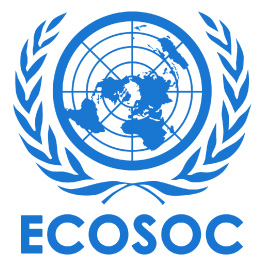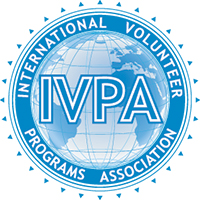What Winter Holidays mean around the Globe
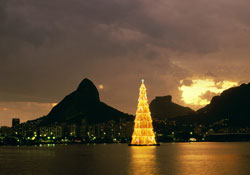 It’s getting to be that time of year again. Time to fish out those coats and bundle up. Its winter. Cultures around the world celebrate at this time of year. So I thought it would be appropriate to take a minute and tell you how some of our program countries choose to celebrate at this time of year. It’s getting to be that time of year again. Time to fish out those coats and bundle up. Its winter. Cultures around the world celebrate at this time of year. So I thought it would be appropriate to take a minute and tell you how some of our program countries choose to celebrate at this time of year.
Ghana – Despite religion almost everyone in Ghana celebrates a Christmas celebration. Gifts aren’t a super common occurrence in Ghana due to lack of money. Though when gift are given they are much more practical such as school books, soap , cloth, candles and other useful goods. Christmas dinner is a big event in Ghana. The biggest Christmas dish in Ghana is fufu (type of stew) and okra soup. For decorations the people of Ghana will laden the palm trees with candles. Don’t be surprised to see a group of singing carolers our either.
Romania - The observance of Christmas was introduced once with the Christianization of Romania but it was then interrupted during the Communist period (1948—1989), as concepts as religion, Jesus Christ or the Church were banned. In the post-communist Romania, Christmas started being celebrated again more festively. The Christmas and holiday season starts officially on November 30, on Saint Andrew's day and ends on January 7, with the celebration of Saint John. Other major holidays in this period are Great Union Day, Saint Nicholas Day, Saint Ignatius Day, Christmas Eve (named Ajunul Craciunului in Romania), Christmas Day (named Craciun in Romania), Saint Stephen day, New Year's Eve (named Revelion in Romania), and the Epiphany. During Christmastime, Romanian bake or buy various special dishes, including desserts, sweets or fries. Romanians most usually bake Cozonac, a somewhat of a Panetone made of flour, yolks, yeast and many other dependable ingredients, flavors, condiments and additions. There are several types of cozonac, with hundreds of recipes. You can either knead it for hours to be out in 6 hours or you can let it crease for 12 hours to avoid kneading it. You can fill the cozonac with chestnuts, cocoa, raisins or Turkish delights. Other Christmas dishes include piftie, sarmale or pork dishes.
Costa Rica - Christmas traditions in Costa Rica began when Christmas was first celebrated in 1601. The governor, Don Vasquez de Coronado organized the festivities and declared it a national holiday. Like Mexico, the Ticos celebrate with Posadas the nine days before Christmas. The Costa Rican Christmas is centered upon the Christ child, and therefore, both the Posada and La Portal( the manger) take a very important position in their celebration. The family portal often occupies the majority of the living room. The children collect plants, mosses, grasses, twigs, and sawdust to decorate it. Portals are completed with crafted wood, statues of Mary, Joseph, The Three Kings,and the shepherds and their sheep. On Noche Buena Christmas Eve, The Christ child is placed in the manger just before the family attends the Misa del Gallo Christmas Midnight Mass. A few days before Christmas, the Christmas tree is placed in the home. It is painted white and may be a small Cyprus tree or dried branches from the coffee plant. It is decorated in a homemade fashion with small figurines, lace ornaments and brightly colored strips of paper. The gold star of Bethlehem crowns the tree. The night before Christmas some Tico children will place their shoes out for the Christ child to fill with treats and small gifts. On Christmas morning, those children are asked, "What did the Baby bring you." I have added some of the traditional Costa Rican food under our recipe section.
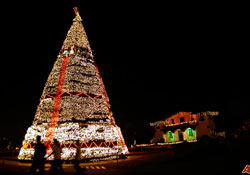 Peru - Early Peruvians immediately identified with the festival of Christmas due to the rural nature of the nativity story, where the baby Jesus was born in a barn. Andean Christmases began taking on characteristics of their own, and it is probably the most important celebration of the year. The Andean people put together Nativity scenes in churches and homes, perform dances and plays, and cook typical dishes. Most families buy the pieces for their nativity scenes at the fascinating market of Santurantikuy, (the buying of the saints), held in the Plaza de Armas on the 24th December. They will keep their nativity scenes until La Bajada de los Reyes (the arrival of the three wise men) on January 6. Peru - Early Peruvians immediately identified with the festival of Christmas due to the rural nature of the nativity story, where the baby Jesus was born in a barn. Andean Christmases began taking on characteristics of their own, and it is probably the most important celebration of the year. The Andean people put together Nativity scenes in churches and homes, perform dances and plays, and cook typical dishes. Most families buy the pieces for their nativity scenes at the fascinating market of Santurantikuy, (the buying of the saints), held in the Plaza de Armas on the 24th December. They will keep their nativity scenes until La Bajada de los Reyes (the arrival of the three wise men) on January 6. 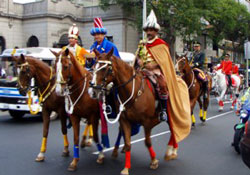 In Cusco, Christmas Eve (known as Noche Buena) is when families get together and celebrate and exchange gifts. Well off families, eat turkey, while for many others chicken suffices. Panetton (a cake/bread filled with fruits) is very popular as are hot drinks of chocolate. In the week preceding Christmas, it is also popular for communities, churches or organisations to organise "chocolatadas" where people who are better off make a Christmas gesture to poor children by offering them a cup of hot chocolate and perhaps a small gift. The lines for chocolatadas are a distinct feature of Christmas in Cusco. In Cusco, Christmas Eve (known as Noche Buena) is when families get together and celebrate and exchange gifts. Well off families, eat turkey, while for many others chicken suffices. Panetton (a cake/bread filled with fruits) is very popular as are hot drinks of chocolate. In the week preceding Christmas, it is also popular for communities, churches or organisations to organise "chocolatadas" where people who are better off make a Christmas gesture to poor children by offering them a cup of hot chocolate and perhaps a small gift. The lines for chocolatadas are a distinct feature of Christmas in Cusco.
Find your perfect volunteer vacation with Globe Aware - CLICK HERE!
|

|
The greatest gift we could have is your participation in our programs and sharing our facebook with others who like to have fun and help people.
|
Stay Involved, Commemorate
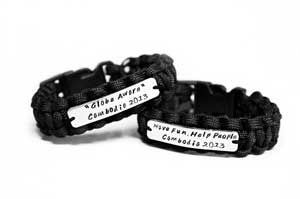 As you reflect upon your program, you may ask yourself “how can I continue to help?” As you reflect upon your program, you may ask yourself “how can I continue to help?”
Purchase this $28.95 survival cord bracelet to memorialize your experience. Proceeds will go toward the purchase of more project materials for the location you choose.
Order Your Commemorative Bracelet Today - CLICK HERE
|
December Volunteer of the Month - Caitlin
This past October, Caitlin was one of the many Vivint employees with the privilege of volunteering in Cambodia. During her visit they helped surrounding communities by digging wells and latrines, fixing leaky roofs and building security fences. Vivint built over 200 wheel chairs to donate to those in need and was able to provide other supplies in high demand. Her favorite project was teaching English lessons at orphanages and local schools, where in return she learned about the Khmer culture and gained a forever love for the country and people who live there. (Especially her guide, Yun Sinet)
And vote for Caitlin on Globe Aware’s Facebook Page!
|
 Globe Aware takes its volunteers’ safety very seriously. Not only do we monitor the U.S. Department of State travel alerts, advisories and warnings and those produced by the equivalent agencies in Canada and the United Kingdom, but we also follow situations in each country closely through our staff on the field and our peer organizations and by calling the Embassies directly. It is our policy to cancel programs whenever there is an official travel advisory issued to a particular country or region. Other warnings are evaluated and assessed, and programs will be adjusted accordingly as Globe Aware deems appropriate. For future travel advice, please stay updated on Globe Aware’s Facebook page for suggestions and insight into current alerts. Globe Aware takes its volunteers’ safety very seriously. Not only do we monitor the U.S. Department of State travel alerts, advisories and warnings and those produced by the equivalent agencies in Canada and the United Kingdom, but we also follow situations in each country closely through our staff on the field and our peer organizations and by calling the Embassies directly. It is our policy to cancel programs whenever there is an official travel advisory issued to a particular country or region. Other warnings are evaluated and assessed, and programs will be adjusted accordingly as Globe Aware deems appropriate. For future travel advice, please stay updated on Globe Aware’s Facebook page for suggestions and insight into current alerts.
|
Travel the World in your Pajamas!
 Globe Aware has joined Pinterest! Globe Aware has joined Pinterest!
Globe Aware has recently joined the online pin board Pinterest. We are sharing beautiful photos for our volunteers past, present and future to add to their own boards. Globe Aware trips are perfect additions to your travel boards, wish list, or bucket list boards. Follow us today! See what other volunteers have experienced: the change they have made in communities as well as the breathtaking beauty of the destination.
CLICK HERE
|
Panettone
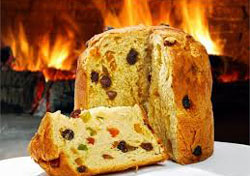 Ingredients: Ingredients:
- 1/2 cup (1 stick) unsalted butter, softened
- 2 eggs
- 3 egg yolks
- 3 1/2 cups all-purpose flour
- 1 cup milk
- 1 cup sugar
- 1/2 cup currants, soaked in warm water for 1 hour and drained
- 2 oranges, zested
- 2 teaspoons cream of tartar
- 1 1/2 teaspoons baking soda
Directions:
-
Preheat the oven to 425 degrees F.
-
Butter and flour an 8-inch round deep cake pan or panettone mold. In a mixer, cream the butter with the eggs and egg yolks until pale yellow, 3 to 4 minutes.
-
Replace the beater with the dough hook attachment, and with the mixer running, add half of the flour. Add half the milk and mix for 1 minute. Add the remaining flour followed by the remaining milk and all of the sugar and mix well. Continue mixing and kneading with the dough hook until the dough becomes dry enough to handle. Turn the dough out onto a floured surface and sprinkle with the currants, orange zest, cream of tartar, and baking soda. Knead by hand for 5 to 10 minutes.
-
Place the dough in the prepared pan and bake for 35 to 45 minutes, or until a wooden skewer inserted in the center comes out clean. The top will be quite cracked. Remove from the oven, invert onto a rack and cool. Slice into wedges to serve.
|
Tico’s Christmas Tamales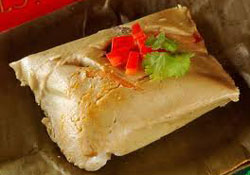
Ingredients:
- 2 lbs instant corn masa mix
- 3 lbs (1.4 kg) pork shoulder roast -or- beef roast -or-
- boneless chicken
- ¼ lb (110 gr) pork lard (or vegetable shortening)
- 1 cup (240 ml) corn oil
- 1 batch (~5 cups cooked Tico style rice, see ingredient list and recipe below)
- 2 ¼ lbs (1 kg) potatoes
- 8 cloves of garlic
- ½ lb (225 gr) sweet or hot peppers to taste
- 1 large onion (optional)
- 2 ¼ lbs (1 kg) banana leaves (corn husks can be substituted, or if desperate aluminum foil)
- coriander leaves (cilantro), salt, black pepper, cumin, oregano, achiote (annato)
Directions:
If you are adventurous and demand complete authenticity, you must start from raw corn ground for tamales (3 lbs, 1.4 kg Maíz cascado, malido crudo). Soak the flour in water then rinse it well, cook with a tablespoon of achiote, and a little of the garlic and peppers in salted water to just cover until tender then stand overnight. The next day, knead it into dough. You should probably have a demonstration first if you're going to try this method. For first timers we'd suggest the Masa version described below.
Chop the meat into large (2", 5 cm) chunks then brown on high heat in the ½ cup lard or vegetable oil. Add the chopped garlic, peppers, onion, 1 teaspoon salt, 1teaspoon cumin, ½ teaspoon black pepper, and 1 teaspoon salt for the last minute or two of browning, then cover with water and simmer until very tender (2-3 hours). Remove the meat from the broth and reserve the broth. When the meat is cool shred it finely. While the meat is simmering prepare the potatoes and rice.
Peel the potatoes and boil with salt, cilantro, and oregano to taste until soft. Cool and cut into ½ inch (1 cm) cubes.
|

|
"Friend" Globe Aware on Facebook and Follow Us on Twitter!
Globe Aware is on Facebook and we are also on Twitter and we would love it if you were to join us!
Please become our friend on Facebook and follow Globe Aware on Twitter. Stay up-to-date with the latest news and the best bits about our many volunteer vacation destination, trips and volunteers. And after you've friended us, please feel free to write on our wall, leave us a comment, share a picture of yourself and invite your other friends to join us as well!
Please add us, follow us and help us give a little back to the many communities around the world.
Call our offices Toll Free 877-LUV-GLOBE (877-588-4562) or 214-206-1421 or email for more information.
|
 
|

|

|
|
|
